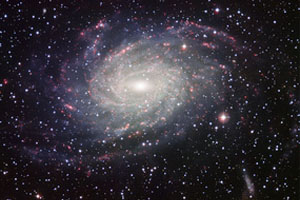 ESO image of galaxy NGC 6744. Credit: ESO
ESO image of galaxy NGC 6744. Credit: ESO
Of all the galaxies in the Universe that we have pictures of, from early photos taken through big ground-based telescopes to the stunningly detailed and far-reaching eye of the Hubble Space Telescope, the one we actually need an artist to paint us a picture of is the one closest to home: our own Milky Way. We're simply too close to it, and can't see the forest for the trees….
So what does it actually look like? Good question. It's the closest galaxy to us—meaning, we're inside it—but we have better pictures of galaxies billions of light years away than we do of our own home.
The Milky Way is known to be a "barred spiral" galaxy, with a dense, elongated central core with an uncertain number of spiral arms pinned to it. It is thought to be about 100,000 light years across, and contain between 100 and 400 billion stars. This fuzzy picture of the Milky Way is put together from observations of the stars we see around us, near and far, and lanes of dust and gas that cloud our view along the galactic plane. We're not sure how the spiral arms of stars, dust, and gas are laid out, or exactly what the overall central core looks like, because most of it is beyond our direct view—much like trying to draw a map of a city by viewing it from inside a single neighborhood.
But, an image of the galaxy NGC 6744, recently released by the European Southern Observatory, may supply us with a photographic example of what the good ol' Milky Way looks like from the outside, for it possesses many of the same characteristics—other than being twice the diameter.
